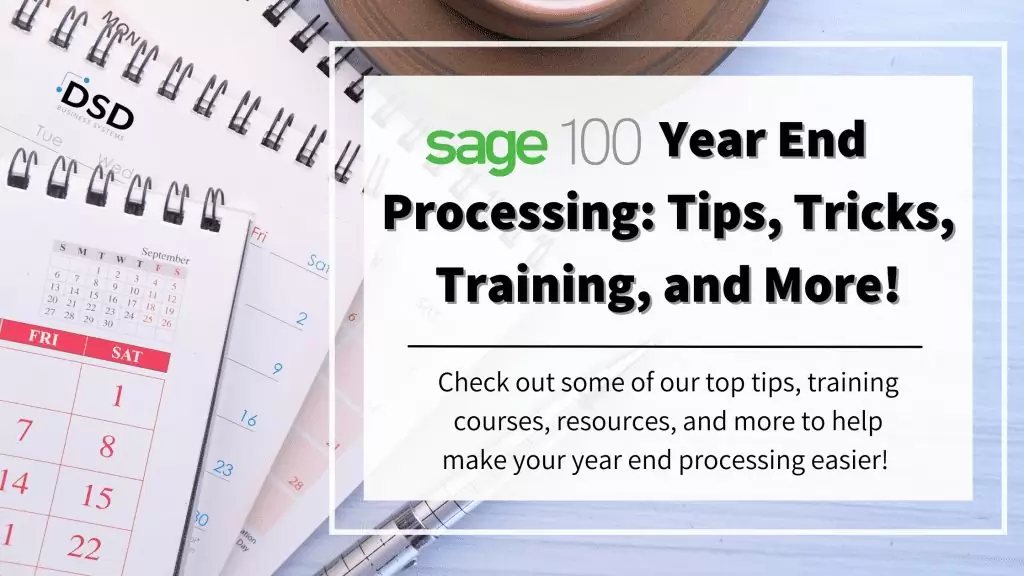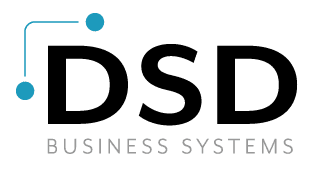Sage 100 Year End Processing: Tips, Tricks, Training & More!
December 9, 2021
by Jared Bollier, Digital Marketing Analyst

Year-end closing is quickly approaching and we know that it can be the busiest time of year and add extra stress to your work life. Luckily, we’ve gathered some great tips and tricks from Sage to help make the process go a little smoother. Read on to learn about these as well as some training and more resources we offer to help make your job a little easier!
Sage 100 Year End Tips and Tricks
Check to see if your accounts are up to date
In your financial accounting, each column of figures should add up accurately and match all of your invoices, bills, deposits, and bank statements. List sales made before the year-end that haven’t been paid for should be listed as outstanding debtors. Include the total amount, invoice number, and date on the invoice.
If you anticipate any bills will not be paid, make a note of them with a brief description. You are not required to run the year-end on the last day of the year. Most companies wait until they’ve processed all of the payments and receipts for the year they’re ending before they close.
Make sure your data is backed up
It is important to keep in mind that when going through the closing process the only way to reverse any mistakes is to restore previous data from a backup version. This is why we highly recommend doing a full backup right before you begin your year-end process. And don’t forget to double-check that backup and make sure everything came out accurately!
Double check your chart of accounts
The chart of accounts, often known as the COA, determines which accounts are related to your profit and loss statement and which are related to your balance sheet. The COA ultimately governs which accounts are cleared for the next year at year’s end, therefore it’s crucial to make sure everything is correct.
Get a refresher on the process
We think it’s incredibly useful to do a little bit of homework before starting the year-end closing process. Luckily, The Sage Customer Support and Training YouTube channel has lots of resources including an overview video that walks you through the entire period and year-end process. This serves as a great refresher! Watch the overview here.
Create a year-end schedule
Preparing for the financial year-end can be a lot of extra work on top of your regular job, To help with organization you can set up year-end calendar reminders and a progress chart to help stay on top of things.
Let your staff know that year-end closing is approaching, and push them to do everything they can to cut costs, gather purchase orders and invoices, submit expenses and close off any remaining orders.
Double Check Your Version Number
Depending on whatever version of Sage 100 you’re using, the closing processes may differ. It’s a good idea to double-check your version number to make sure you’re on the right track. You can check this info by Selecting Help then selecting About Sage 100.
Make sure employee data is up to date
Double-check that your payroll and expense calculations are correct at year-end. Making sure that all this info is accurate can save you from a lot of trouble down the road of the year-end process. A helpful tip throughout the year is to maintain track of all cost claims and have employees attach the proper receipts to their expense forms.
When to close General Ledger
A useful tip to keep in mind is that having General Ledger open throughout your closing process won’t prevent you from things such as entering transactions for the new year. You can leave it open throughout your process while you are closing other modules or making any needed adjustments.
Make sure to follow the Module Closing Order
It’s important to remember that the data written in certain modules may affect data in others. As a result, closing modules in the correct order is critical to avoid unexpected outcomes or data corruption. Paying close attention to this can save you lots of time in the long run.
Follow the Module Closing Checklists
Sage has created very detailed checklists for each module for users to help with the process. These checklists outline the order in which each module’s specified activities and processes should be carried out. You can find these checklists within the Sage 100 Help System.
Sage 100 Year End Training
Now is the time to start planning so that the year-end closing process will be smooth and stress-free and DSD wants to help by offering a series of classes packed with process training and best practices for a successful year-end close. Join us for our Annual Sage Year-End Training Series covering Year-End Processing in Sage 100, Sage Payroll, Sage HRMS Payroll, and Sage 100 Period End Reporting!
More Sage 100 Year End Resources
Want to see more Sage 100 Year-End Resources? We’ve got you covered! Check out our resource page covering everything from Frequently Asked Questions, Checklists, Product Updates, and more!








